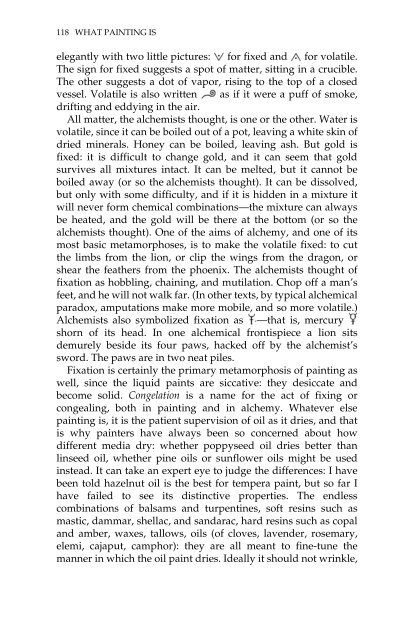What Painting Is: How to Think about Oil Painting ... - Victoria Vesna
What Painting Is: How to Think about Oil Painting ... - Victoria Vesna
What Painting Is: How to Think about Oil Painting ... - Victoria Vesna
You also want an ePaper? Increase the reach of your titles
YUMPU automatically turns print PDFs into web optimized ePapers that Google loves.
118 WHAT PAINTING IS<br />
elegantly with two little pictures: for fixed and for volatile.<br />
The sign for fixed suggests a spot of matter, sitting in a crucible.<br />
The other suggests a dot of vapor, rising <strong>to</strong> the <strong>to</strong>p of a closed<br />
vessel. Volatile is also written as if it were a puff of smoke,<br />
drifting and eddying in the air.<br />
All matter, the alchemists thought, is one or the other. Water is<br />
volatile, since it can be boiled out of a pot, leaving a white skin of<br />
dried minerals. Honey can be boiled, leaving ash. But gold is<br />
fixed: it is difficult <strong>to</strong> change gold, and it can seem that gold<br />
survives all mixtures intact. It can be melted, but it cannot be<br />
boiled away (or so the alchemists thought). It can be dissolved,<br />
but only with some difficulty, and if it is hidden in a mixture it<br />
will never form chemical combinations—the mixture can always<br />
be heated, and the gold will be there at the bot<strong>to</strong>m (or so the<br />
alchemists thought). One of the aims of alchemy, and one of its<br />
most basic metamorphoses, is <strong>to</strong> make the volatile fixed: <strong>to</strong> cut<br />
the limbs from the lion, or clip the wings from the dragon, or<br />
shear the feathers from the phoenix. The alchemists thought of<br />
fixation as hobbling, chaining, and mutilation. Chop off a man’s<br />
feet, and he will not walk far. (In other texts, by typical alchemical<br />
paradox, amputations make more mobile, and so more volatile.)<br />
Alchemists also symbolized fixation as —that is, mercury<br />
shorn of its head. In one alchemical frontispiece a lion sits<br />
demurely beside its four paws, hacked off by the alchemist’s<br />
sword. The paws are in two neat piles.<br />
Fixation is certainly the primary metamorphosis of painting as<br />
well, since the liquid paints are siccative: they desiccate and<br />
become solid. Congelation is a name for the act of fixing or<br />
congealing, both in painting and in alchemy. <strong>What</strong>ever else<br />
painting is, it is the patient supervision of oil as it dries, and that<br />
is why painters have always been so concerned <strong>about</strong> how<br />
different media dry: whether poppyseed oil dries better than<br />
linseed oil, whether pine oils or sunflower oils might be used<br />
instead. It can take an expert eye <strong>to</strong> judge the differences: I have<br />
been <strong>to</strong>ld hazelnut oil is the best for tempera paint, but so far I<br />
have failed <strong>to</strong> see its distinctive properties. The endless<br />
combinations of balsams and turpentines, soft resins such as<br />
mastic, dammar, shellac, and sandarac, hard resins such as copal<br />
and amber, waxes, tallows, oils (of cloves, lavender, rosemary,<br />
elemi, cajaput, camphor): they are all meant <strong>to</strong> fine-tune the<br />
manner in which the oil paint dries. Ideally it should not wrinkle,


